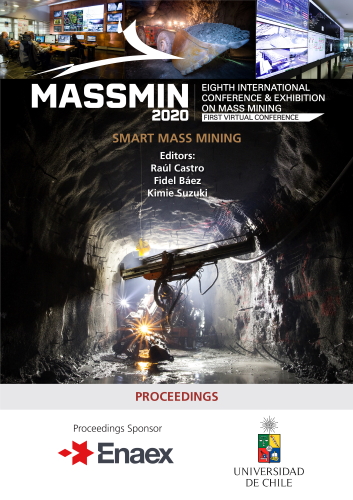Driving and managing stress in the Deep Mill Level Zone caving mine

|
Authors: Simanjuntak; K; Primadiansyah, A; Soumilena, N; Teweng, W |
This paper is hosted with the kind permission of Lulea University of Technology, International Conference & Exhibition on Mass Mining, 2024.
DOI https://doi.org/10.36487/ACG_repo/2063_25
Cite As:
Simanjuntak, K, Primadiansyah, A, Soumilena, N & Teweng, W 2020, 'Driving and managing stress in the Deep Mill Level Zone caving mine', in R Castro, F Báez & K Suzuki (eds), MassMin 2020: Proceedings of the Eighth International Conference & Exhibition on Mass Mining, University of Chile, Santiago, pp. 394-405, https://doi.org/10.36487/ACG_repo/2063_25
Abstract:
The Deep Mill Level Zone (DMLZ) panel cave mine in PT Freeport Indonesia continues to ramp up production since initial undercutting began in 2015. At approximately 1,500 m below surface, the DMLZ is one of the world’s deepest caving operations. The current undercut area has reached 60,000 m2, within a 1,200 m triangular-shaped perimeter. This deep mining environment has given rise to substantial pre-mining and induced loading conditions. Stress management in production areas represents the toughest challenge to date for the operation. In addition to applying lessons learned from the overlying Intermediate Ore Zone (IOZ) and Deep Ore Zone (DOZ) mines, extensive empirical ground response data has been collected from undercut and extraction levels. The understanding of how the various geological, geotechnical and mine design criteria interact has resulted in a much-improved approach towards DMLZ stress management. The most notable successes related to DMLZ stress management include improved understanding of ground response, accelerated cave growth, and increased production rates. This paper summarizes the key learnings regarding stress management in production areas and outlines positive improvements undertaken towards sustained, safe caving in the DMLZ.
References:
Beck Engineering 2019a,’Initial appreciation of the March 2019 to March 2020 draw plan vs recommended strategy’, in report DMLZ2019FEB26, Beck Engineering, Sydney, p.5.
Beck Engineering 2019b,’Stress vs. Advance 2019’, in report FMI20192019NOV11, Beck Engineering, Sydney, p.4.
Bucher, RJ 1999, ‘Design rules for avoiding draw horizon damage in deep level block caves’, Journal of The South African Institute of Mining and Metallurgy, SAIMM, vol 1, pp. 151-156.
Casten, T, Golden, R & Mulyadi, A 2000, ’Excavation Design and Ground Support of the Gyratory Crusher Installation at the DOZ mine, PT Freeport Indonesia’, Proceedings of Massmin 2000, Brisbane, 29 October to 2 November 2000.
Erhardt, M, Simanjuntak, K, Primadiansyah, A, Teweng, W, Perez, AB & Hout, GV 2019, ‘Monitoring cave back propagation to inform cave management strategy’, Massmin 2020, Santiago, 4-7 October 2020.
Golder Associates 2018a,’ DMLZ Flac3D model: model details and calibration’, in report 1404134-322-R-Rev0-37000, Golder Associates, Ltd., Vancouver, pp. 22-33.
Golder Associates 2018b,’ Review of Grasberg stress measurement and new interpretation’, in report 1404134-426-PP-Rev0-25000, Golder Associates, Ltd., Sudbury, p. 4.
Kaiser, PK 2017, ’Ground control in strainbursting ground – A critical review and path forward on design principles’, RaSiM9 2017, Santiago, 15-17 November 2017.
© Copyright 2025, Australian Centre for Geomechanics (ACG), The University of Western Australia. All rights reserved.
View copyright/legal information
Please direct any queries or error reports to repository-acg@uwa.edu.au
View copyright/legal information
Please direct any queries or error reports to repository-acg@uwa.edu.au
